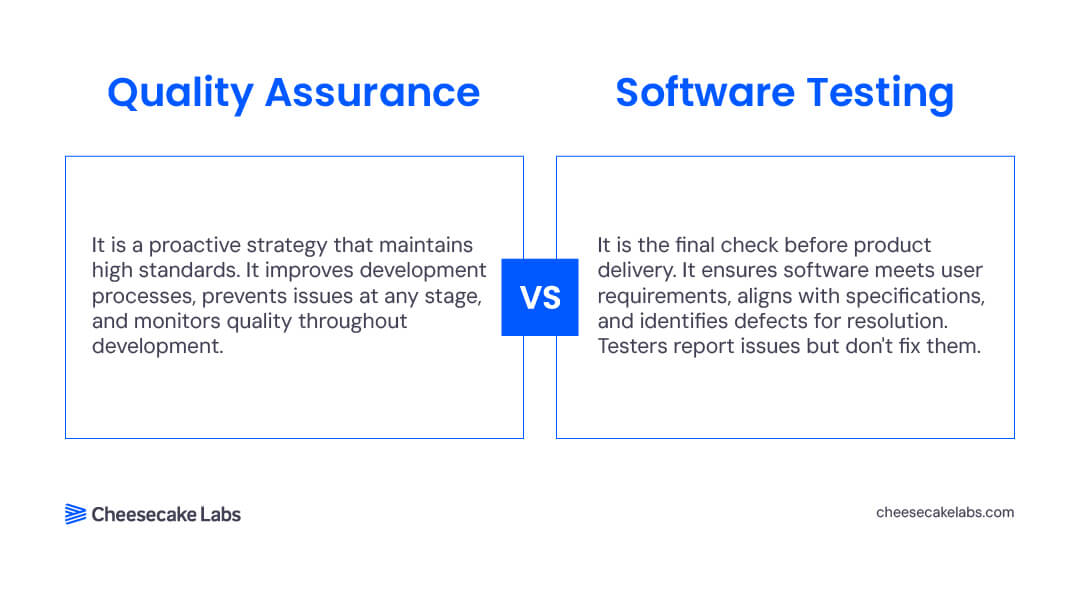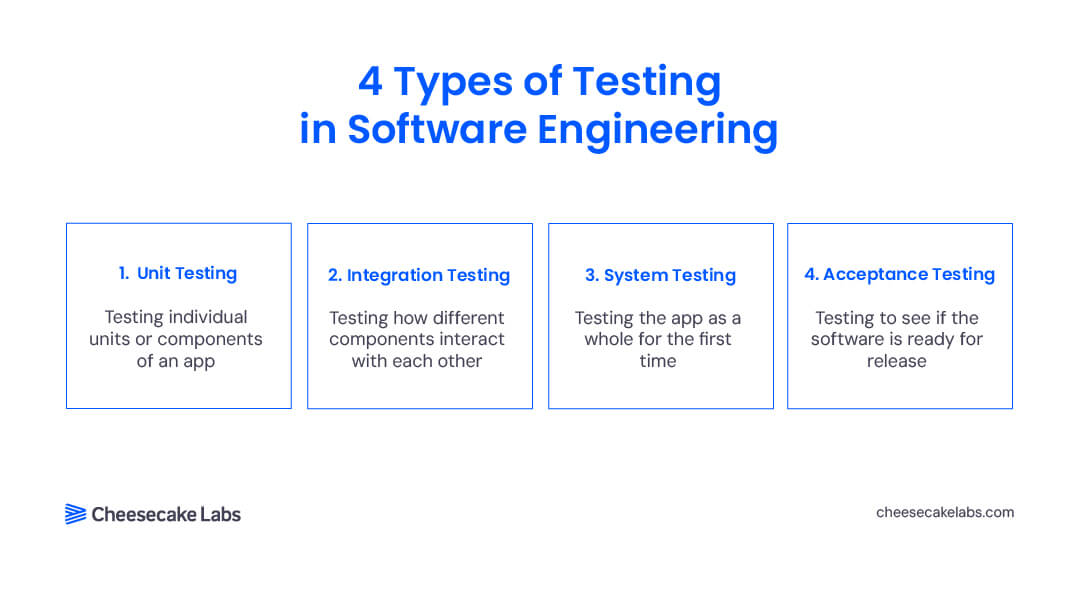Beyond “Vibe Coding”: Engineering with AI and Cursor
Jonathan Felipe de Oliveira, Igor Brito, Antony Ferreira, Lucas Magnus, Marcelo Bittencourt | Jan 07, 2026

A great digital product is not just stable — it also wows and hooks users, keeping them engaged and loyal. Quality assurance (QA) is the X-factor that makes this possible. According to estimates, every $1 invested in QA boosts revenue by $6, reduces costs by $16, and increases profits by $3.
In this post, we’ll uncover what quality assurance means and look at some software QA best practices to supercharge your project. We’ll also take you behind the scenes, revealing our proven quality formula here at Cheesecake Labs!
Fundamentally, QA evaluates and tests software code during development to check if it works as intended. But that’s just scratching the surface. Quality assurance in web and mobile development extends far beyond delivering a bug-free script. It also means:
Software quality management is a complete system of setting and following standards to create reliable software. By following best practices in QA, you can improve your brand’s reputation, build customer trust, streamline workflows, and outpace the competition.
Investing in software quality practices through the software development cycle not only helps you create a top-notch product but also aligns with your broader business goals.
Here’s why QA is so important.
Because quality assurance is proactive, it doesn’t just identify bugs — it prevents them in the first place. The result is a reliable, easy-to-use, and efficient product.
Remember BlackBerry? Once a smartphone market giant, the company ultimately fell from grace due to quality assurance issues. Investing in QA can help you avoid software glitches, security vulnerabilities, and system crashes that can tarnish your market standing.
Well-tested software is easier to maintain and update. QA makes it simpler to add features, fix issues, or adapt to new technologies down the line.
Quality assurance identifies issues early on so you don’t waste resources trying to fix them later. Any bugs that do arise are likely minor and easier to fix during development.
You need a superior product to stand out in a saturated software market. QA can help you exceed industry standards and give you a competitive advantage.
Security can’t be an afterthought — it has to be integrated into software development from the beginning. QA addresses vulnerabilities to safeguard both your data and your customer’s data.
Whether you’re building an application for clients or end-users, you need QA to deliver a product that meets user expectations.
QA reveals usability roadblocks so you can make targeted improvements, such as adding keyboard navigation and screen reader support.

While both quality assurance and software testing aim to deliver a high-quality product, they serve different functions in the development cycle.
Software testing is a specific and targeted activity and serves as a “final check” before the product reaches customers. It aims to:
Note that software testers look for issues but do not have the responsibility to fix them. They simply report these problems.
In contrast, quality assurance is a preemptive and ongoing strategy that enhances and maintains high standards throughout development. It involves:
So while “software testing” is an essential component, it is only a subset of the broader “quality assurance” strategy. Software testing seeks to identify and report issues in a finished or near-finished product, while QA aims to improve processes and prevent issues from arising in the first place.

There are four primary levels of testing:
This initial stage evaluates specific components or units of the software to check if they work as designed. A unit could be a function, a particular program segment, or even a procedure.
White-box testing techniques are commonly used where testers are given complete knowledge of the software, including access to design documents and source code.
One advantage of unit testing is that it can be done repeatedly whenever your code changes, making it easier to catch issues early on.
The second level catches any defects in the connections between different modules or functions. This is important because improper integration hampers the entire program’s functionality (even if individual units work well independently.)
Integration testing can be done in two ways: top-down or bottom-up.
The best approach for your project depends on various considerations:
At this level, the software is examined in its entirety to validate if it meets all specified requirements and quality standards. Independent testers who haven’t been involved in the development process perform this test in an environment that closely simulates real-world conditions.
The final stage assesses if the software fulfills the end user’s needs. This is crucial because requirements can sometimes change or lose clarity during the development process. Once this test is complete and the software passes, it can be released into production.
Acceptance testing is broken down into two major phases:
As you can see, each testing level allows for progressively detailed audits. This is why early QA is crucial for preventing bigger bugs and improving overall quality.
Whether you’re building a mobile app or an enterprise-level solution, you want a product that works well and delights users. These software QA best practices can help your team achieve your goals:
Clarify both software requirements and customer expectations before you start testing. The QA team needs this information to meet quality standards and satisfy customers. It can also help you estimate the resources required for testing.
Create a detailed workflow to enhance communication between the QA team and the client while making tests more efficient. The workflow should include:
Begin testing as soon as a new feature is developed to quickly identify and resolve issues. For example, be sure to test a newly developed login feature immediately before integrating it into the larger system.
Did you add new features? Re-test the app to confirm that existing functionalities remain unaffected. If you added a currency conversion feature to your financial software, for example, you need to check that it doesn’t disrupt basic transactions.
While manual tests are useful for tasks requiring human interpretation and judgment, automation effectively handles repetitive tasks. Don’t hesitate to use automation to speed up testing and cover more scenarios.
For example, you can automate test cases that validate data entry fields or use automated scripts to perform load testing. This lets you achieve more comprehensive and reliable results, often with less time and effort.
Don’t ignore edge cases and error conditions. If you have an e-commerce app, it’s not enough to just test the purchase flow for popular items. Be sure to cover less common scenarios. What happens when a user tries to buy an out-of-stock item or applies multiple discount codes at checkout?
Create a communication channel for quickly escalating issues. If a bug appears in the payment gateway, the QA team should have a defined process for notifying the development team.
Keep detailed documentation to track progress and help recreate any problems that arise. Record all test cases where payment transactions fail, for example. This documentation can help developers pinpoint the root cause of issues.
Test how the software behaves under different conditions. Try simulating high-traffic scenarios to check if the software maintains its speed and reliability. You can also perform stress tests to identify any weak points. This confirms the software’s reliability in the real world.
Recruit beta testers to interact with new features and provide feedback. Focus on elements like navigation ease, instruction clarity, and overall user satisfaction, and then use the feedback collected to make necessary adjustments.
Regularly check your QA process for bottlenecks and inefficiencies, then make data-driven adjustments to streamline workflows and reduce errors. Do you notice that certain tests consistently cause delays? Investigate the cause and implement solutions. The goal is to create a more efficient and effective QA process that continually adapts to new challenges and requirements.
Here at Cheesecake Labs, we believe that quality is not just an endgame but a journey that begins from the first line of code. Here’s our approach to maintaining quality standards.
Our QA process is a team effort that involves not just our software engineers but also the product owner. After all, the product owner plays a key role in defining the project’s requirements and acceptable criteria. Their involvement is essential in building a final product that matches what was originally agreed upon.
Every project repository at Cheesecake Labs has automated routines in place to assess static code quality, dependency, and library vulnerabilities.
We perform rigorous peer reviews before merging any new code into the main application branch. At least two peers must review and approve the feature merge request, ensuring that multiple sets of eyes have scrutinized the code for quality.
Our engineers are not just coders — they are quality gatekeepers. They follow best practices in software testing, implement a mix of unit and integration tests, and adhere to predefined coding standards.
We customize the depth and breadth of our testing protocols based on the unique requirements and goals outlined in our client agreement. This lets us focus on the most critical quality checks for each specific project, making the QA process more targeted and effective.
At Cheesecake Labs, we weave software testing best practices throughout the development lifecycle. Here’s a look at its key components:
At Cheesecake Labs, our QA delivery process is more than a checklist — it’s a commitment to delivering software that exceeds expectations. By following software QA best practices, we deliver robust, secure, and high-performance solutions that foster confidence among our clients and end-users.

Want to guarantee the best quality for your app? Looking to outsource software quality assurance services? Get in touch with Latin America’s Top Development Company — we can’t wait to chat with you!

VP of Engineering at Cheesecake Labs - IA / IoT enthusiast. Go bravely where no one have never gone before!


